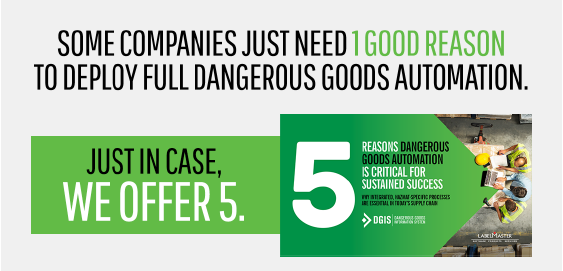

Week of October 3rd, 2022
Linking supply chain news with dangerous goods compliance
Ongoing global supply chain disruptions continue to put pressure on organizations, and executives have been vocal regarding the key challenges they face and their top priorities moving forward.
Let’s examine some recent industry news.
SUPPLY CHAIN NEWS
- Dangerous Goods Transport Survey Highlights Challenges: The 7th annual 2022 Global Dangerous Goods Confidence Outlook underscores the need for greater process consistency and automation to facilitate safe hazmat transport.
- Global Supply Chain Trends 2022: IHS Markit’s new “Supply Chain Survey Report 2022” addresses the results of its annual query of global supply chain executives examining industry challenges and priorities.
- Meeting the Challenge of Supply Chain Disruption: Deloitte examines how traditional manufacturing supply chains are evolving to balance costs, efficiency, and resilience.
- CFOs Adjusting Supply Chain Models: CFOs and finance leaders are moving away from efficiency-based supply chain models (e.g., low-cost, just-in-time) to revenue assurance models that emphasize flexibility and resilience, a new survey said.
- Supply Chain Execs Anticipate Delivery Delays, Inflation This Peak Season, Survey Shows: Supply chain executives expect the holiday shipping season, or peak season, to be negatively impacted by delivery delays, price escalation and labor issues, according to a recent survey.
- Gartner Survey Shows 74% of Supply Chain Leaders Expect Circular Economy to Increase Profits Through 2025: A recent Gartner survey found that 74% of supply chain leaders expect profits to increase between now and 2025 as a result of applying circular economy principles.
OUR PERSPECTIVE
- Improvements are needed. Organizations around the world recognize the need for supply chain improvements – whether it’s controlling costs, reducing risk or improving resilience. Regardless of industry, location or challenges, there is an overwhelming emphasis on the need for better use of technology, greater collaboration with supply chain partners and the use of timely and accurate data.
- Consider the compliant factor. Compliance plays a role in nearly every part of the supply chain. As a result, gaps within DG management processes can negatively affect the entire supply chain, exacerbating existing challenges and limiting improvement efforts. Compliance may not always be top of mind for executives, but they cannot afford to overlook its impact on their organizations.
- Meaningful improvement doesn’t have to be difficult. The results of the 7th annual 2022 Global Dangerous Goods Confidence Outlook highlighted the need to improve DG processes, training, technology and infrastructure. The good news is that making meaningful improvements does not have to be difficult or require significant investment. Check out the Labelmaster Compliance Roadmap for practical steps to creating a better DG supply chain.
To learn more about Dangerous Goods software or how to establish a safer, more compliant supply chain, visit https://www.labelmaster.com.
Have questions about Dangerous Goods transport? Call the Labelmaster Regulatory Hotline at 1.800.621.5808.
Automation is the key to handling today’s supply chain challenges. But without true Dangerous Goods automation, you may be operating at a competitive disadvantage.
Integrating Labelmaster’s DGIS with your existing TMS, ERP, WMS or OMS platforms puts Dangerous Goods information in the same window as all your other shipping information. Hazmat shipments become as simple as non-regulated shipments—a seamless part of your normal workflows.
Our new eBook explains how integrating DGIS with your existing automation platforms can help your organization sustain success in today’s supply chain.




